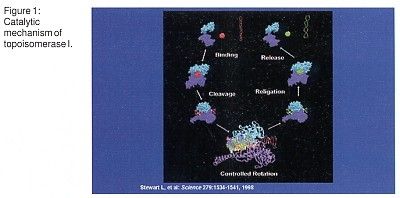Multiple Mechanisms of Resistance to Camptothecins
NEW BRUNSWICK, New Jersey-Although camptothecins can cure colon cancer in animals, they are active but not curative in human tumors. The question of why drugs that are effective in animal models are sometimes less effective in clinical studies, as well as issues related to resistance to cytotoxic drugs were discussed by Eric H. Rubin, MD. Dr. Rubin is associate professor at the Cancer Institute of New Jersey, Robert Wood Johnson Medical School in New Brunswick.
NEW BRUNSWICK, New JerseyAlthough camptothecins can cure colon cancer in animals, they are active but not curative in human tumors. The question of why drugs that are effective in animal models are sometimes less effective in clinical studies, as well as issues related to resistance to cytotoxic drugs were discussed by Eric H. Rubin, MD. Dr. Rubin is associate professor at the Cancer Institute of New Jersey, Robert Wood Johnson Medical School in New Brunswick.
"The topoisomerases have been exploited by nature as good targets for cytotoxicity," Dr. Rubin said. "There are many naturally occurring antibacterial and antineoplastic compounds that target topoisomerases."
The catalytic mechanism of topoisomerase I involves binding, cleavage, controlled rotation, religation, and release (Figure 1). "Possible mechanisms of resistance to irinotecan [Camptosar] seen in cell culture models include alterations in irinotecan metabolism, cellular accumulation of irinotecan or SN-38, SN-38 interaction with the topoisomerase I-DNA complex, and processing of topoisomerase I-mediated DNA damage," Dr. Rubin explained. "Cell culture models provide evidence for multiple mechanisms of irinotecan resistance, but clinical relevance has not been established for any of the resistance mechanisms identified in cell culture models."

Several Mechanisms Reported
Decreased carboxylesterase activity and increased glucuronidation have been reported in several irinotecan-resistant cell lines. Variable carbox-ylesterase activity has been observed in both normal and tumor tissues. Dr. Rubin said that the ratio of tumor to normal cell carboxylesterase activity is probably critical in determining the therapeutic index of irinotecan.
A second resistance mechanism involves the failure of irinotecan/SN-38 to accumulate in the cell nucleus. "Drug efflux is clearly implicated in certain resistant cell lines," Dr. Rubin said. This is thought to involve efflux proteins including P-glycoprotein, MRP-1, cMOAT, PDR5, SNQ2, and BCRP/MXR/ABCP.
"There appears to be analogue specificity to this process," Dr. Rubin said. "BCRP/MXR/ABCP affects topotecan [Hycamtin] and SN-38, but not the parental drug camptothecin."
A third mechanism of resistance occurs when SN-38 does not stabilize the cleavable complex. Dr. Rubin said that topoisomerase I down-regulation or mutation is commonly observed in resistant cell lines and that variable levels of topoisomerase I have been reported in tumor specimens. Resistance-conferring mutations have not yet been reported in clinical specimens, however, and one negative study published found no mutations in 56 patients with lung cancer.
Resistance can also occur if the drug does not stabilize the cleavable complex due to mislocalization of topoisomerase I. Dr. Rubin said that this can result from ubiquitination of topoisomerase I.
"Camptothecin treatment leads to rapid topoisomerase I ubiquitination and down-regulation in cells, and camptothecin-induced topoisomerase I degradation correlates with sensitivity in cell lines," Dr. Rubin said.
Resistance may also occur if camptothecin-stabilized cleavable complexes do not result in cell death.
How Supportive Care Methods Can Improve Oncology Outcomes
Experts discussed supportive care and why it should be integrated into standard oncology care.